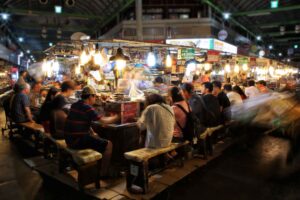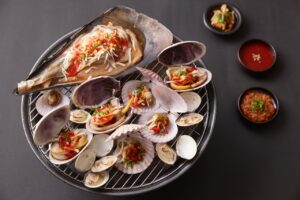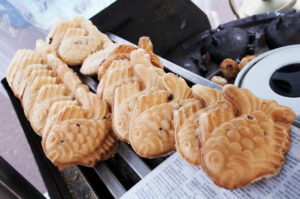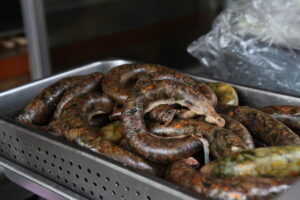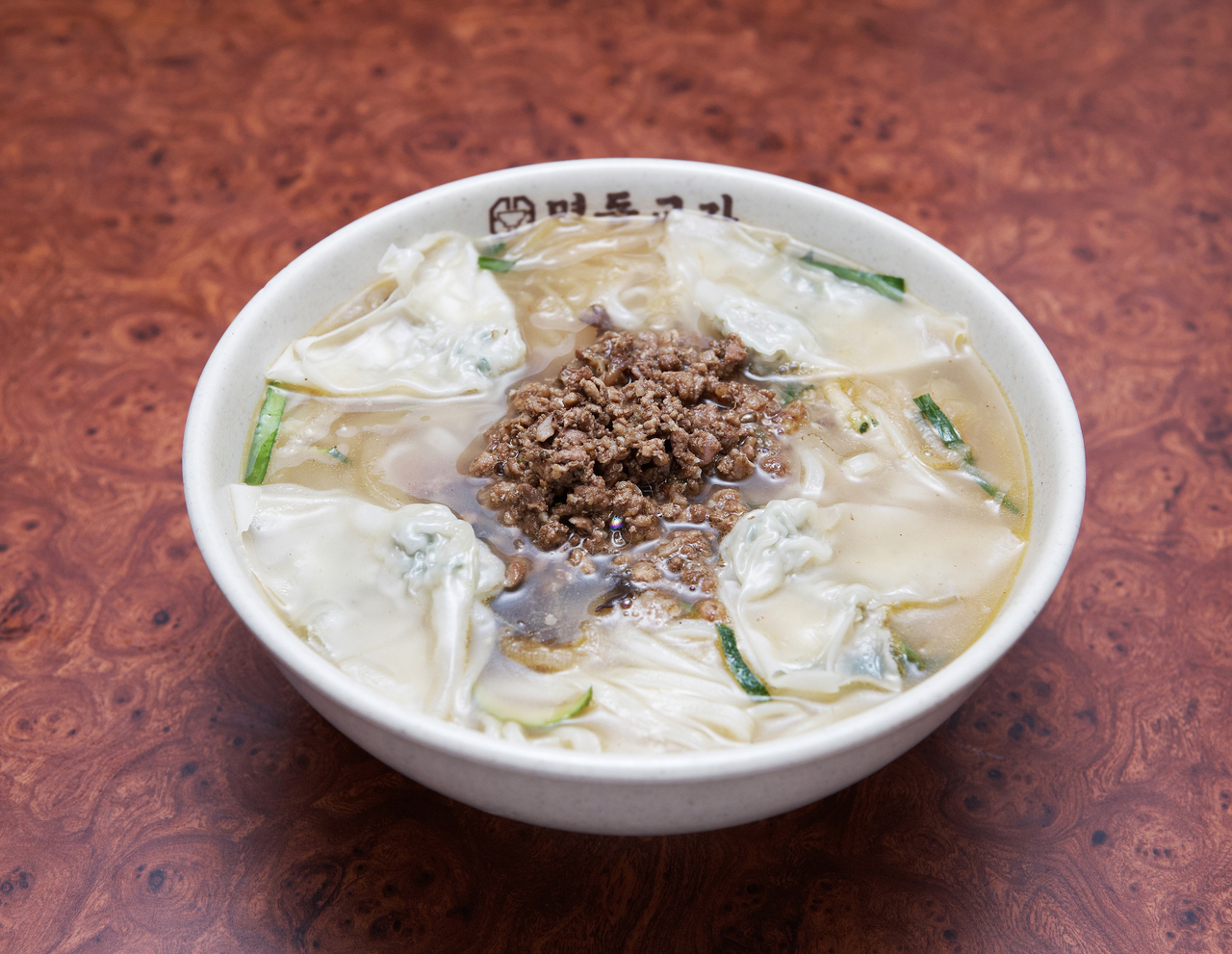
Kalguksu ⓒ한국관광공사 사진갤러리-한국관광공사 브이앤드
What is Kalguksu?
Kalguksu (칼국수) is a traditional Korean noodle soup made with handmade knife-cut noodles. The name “kalguksu” translates to “knife noodles” in Korean, referencing the process of making the noodles by cutting the dough with a knife. This dish is a comforting and beloved part of Korean cuisine, often enjoyed year-round. Here’s more about kalguksu:
Noodles: Kalguksu noodles are handmade from a dough of wheat flour, water, and sometimes a bit of salt. The dough is rolled out and then cut into thin, flat noodle strips using a knife. This method gives the noodles a rustic and uneven appearance, which contributes to the dish’s charm.
Soup Base: The broth for kalguksu is typically made by simmering ingredients like chicken, seafood, or anchovies with vegetables to create a flavorful base. The broth can vary in taste and richness, with some versions being more mild and others more robust.
Variations: There are several variations of kalguksu, each with its own unique flavors and ingredients. Some popular variations include:
Seafood Kalguksu: This version features a seafood-based broth, often with ingredients like clams, shrimp, squid, and various fish. It’s known for its delicate and slightly briny flavor.
Chicken Kalguksu: This variation uses a chicken-based broth and is often enjoyed with shredded chicken meat and vegetables.
Vegetable Kalguksu: For a vegetarian option, vegetable broth is used, and the dish is filled with a variety of fresh vegetables.
Spicy Kalguksu: Some versions of kalguksu include spicy elements, often with gochugaru (red pepper flakes) added to the broth for a kick of heat.
Toppings and Accompaniments: Kalguksu is typically served with various toppings and accompaniments, such as sliced vegetables, mushrooms, kimchi, and sometimes a boiled egg. Diners can customize their bowls by adding these elements according to their preferences.
Regional Variations: Kalguksu is enjoyed throughout South Korea, and different regions may have their own variations and local ingredients. For example, coastal areas might incorporate more seafood, while mountainous regions might use wild greens.
Cultural Significance: Kalguksu holds cultural significance as a comforting and satisfying dish. It’s often enjoyed as a way to warm up during colder months, but it’s also a favorite year-round.
Modern Variations: While traditional kalguksu remains popular, modern interpretations may incorporate additional ingredients, fusion flavors, and creative presentations.
In summary, kalguksu is a traditional Korean noodle soup made with handmade knife-cut noodles and flavorful broths. Its rustic charm, regional variations, and heartwarming qualities make it a beloved and enduring part of Korean culinary culture.


Image source from : Hansikmagazine by 한식진흥원
한식진흥원 : 무심하게 뽑은 수제 면발의 마력, 원조 손칼국수 (hansikmagazine.org)
Where to Eat?
서울 손칼국수 맛집_<원조 손칼국수>
A 서울시 성북구 종암로 113 국승호치과의원
T 02-923-0681
H 11:00-20:30
Cooking Method
Ingredients for the soup base:
- 8 cups chicken or vegetable broth
- 1 onion, roughly chopped
- 3 cloves garlic, minced
- 2 tablespoons soy sauce
- 1 tablespoon sesame oil
- Salt and pepper to taste
Ingredients for the noodles and toppings:
- 2 cups all-purpose flour
- 1/2 teaspoon salt
- About 1/2 cup water
- 1 cup sliced mushrooms
- 1 cup zucchini, julienned
- 1 cup spinach, roughly chopped
- 1 cup cooked chicken or seafood (optional)
- 2 green onions, chopped
- Roasted seaweed (gim/gim-gui), cut into thin strips (optional)
- Toasted sesame seeds for garnish
Instructions:
- Prepare the soup base: In a large pot, combine the chicken or vegetable broth, chopped onion, minced garlic, soy sauce, and sesame oil. Season with salt and pepper to taste. Bring the mixture to a boil and then reduce the heat to let it simmer while you prepare the noodles and toppings.
- Make the noodle dough: In a mixing bowl, combine the all-purpose flour and salt. Gradually add water while kneading the dough until it forms a smooth and elastic ball. You may need more or less water depending on humidity and other factors. Cover the dough with a damp cloth and let it rest for about 15-20 minutes.
- Roll and cut the noodles: On a floured surface, roll out the dough into a thin sheet. You can use a rolling pin or pasta machine if you have one. Once the dough is rolled out, fold it over several times to create layers. Cut the folded dough into thin strips using a sharp knife. Unfold the noodles and separate them carefully.
- Cook the noodles: Bring a separate pot of water to a boil and add a pinch of salt. Cook the noodles in boiling water for about 3-4 minutes or until they are tender but still slightly chewy (al dente). Drain the noodles and rinse them with cold water to prevent them from sticking together.
- Cook the toppings: In a pan, sauté the sliced mushrooms, julienned zucchini, and chopped spinach until they are cooked through but still vibrant and slightly crunchy.
- Assemble the Kalguksu: In individual serving bowls, place a portion of the cooked noodles. Ladle the hot soup base over the noodles, covering them completely. Add the sautéed vegetables and cooked chicken or seafood (if using) on top of the noodles and broth.
- Garnish with chopped green onions, roasted seaweed strips (if using), and toasted sesame seeds.
- Serve the Kalguksu hot and enjoy!
Famous place for Kalguksu in Korea
There are numerous places in South Korea where you can find delicious and famous one. Keep in mind that the popularity of specific restaurants may vary over time, but here are a few well-known places for kalguksu in different regions of Korea:
- Myeongdong Kyoja (명동교자) – Seoul: Myeongdong Kyoja is a renowned restaurant in Seoul known for its handmade one and other traditional Korean noodle dishes. The restaurant has been serving these dishes for decades and is a favorite among locals and visitors.
- Sikmul Kalguksu (식물칼국수) – Jeonju: Jeonju is known for its rich culinary heritage, and Sikmul Kalguksu is a popular spot in the city to enjoy the local style of it. The noodles here are often made with a mixture of wheat and buckwheat flour, resulting in a unique flavor and texture.
- Namwon Kalguksu (남원칼국수) – Namwon: Namwon, located in North Jeolla Province, is famous. Namwon Kalguksu is particularly renowned for its hearty and flavorful chicken one, making it a must-visit for those exploring the region.
- Busan Milmyeon (부산밀면) – Busan: While not traditional one, Busan Milmyeon is a well-known spot in Busan that serves a similar dish called “milmyeon,” which features thin wheat noodles in a spicy broth with various toppings.
- Dongbaekseom Kalguksu (동백섬칼국수) – Gangneung: Located in the coastal city of Gangneung, Dongbaekseom Kalguksu offers a unique version of it that includes fresh seafood sourced from the region’s waters.
- Andong Jjimdak & Kalguksu Alley (안동찜닭&칼국수거리) – Andong: This alley in Andong is famous for both kalguksu and jjimdak (a braised chicken dish). It’s a great place to sample the local flavors of both dishes.
Recommend to Read >> JogaeGui, The Most Famous Shellfish Dishes Nov. 2023 – Korean Food Nearby
